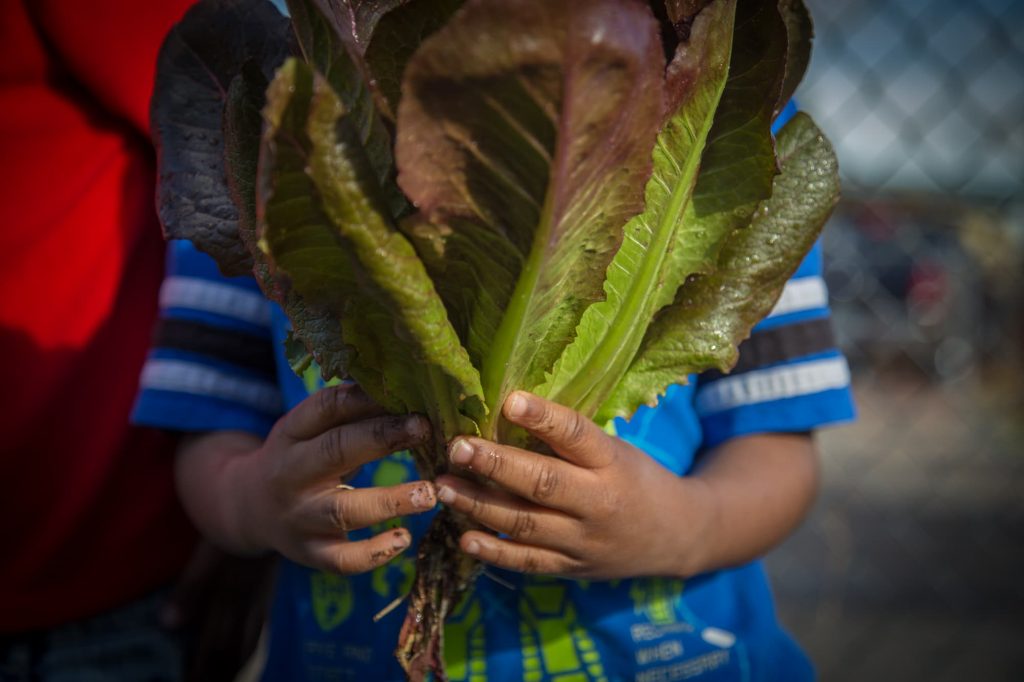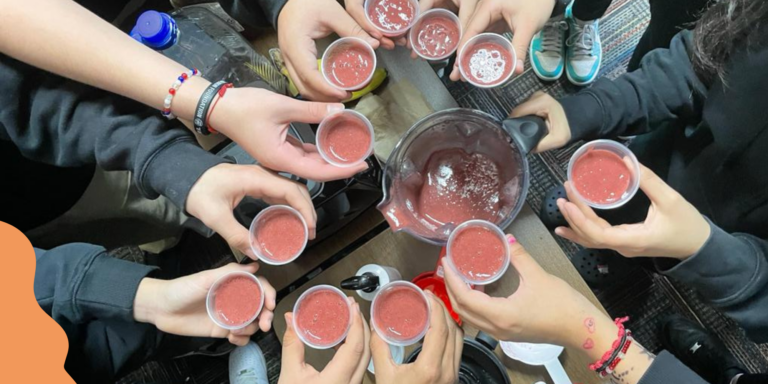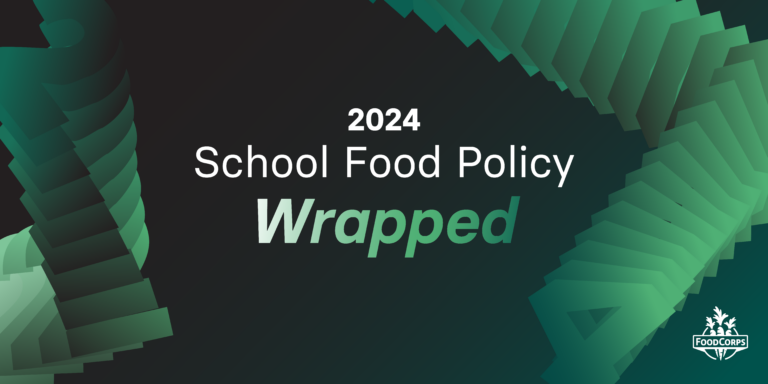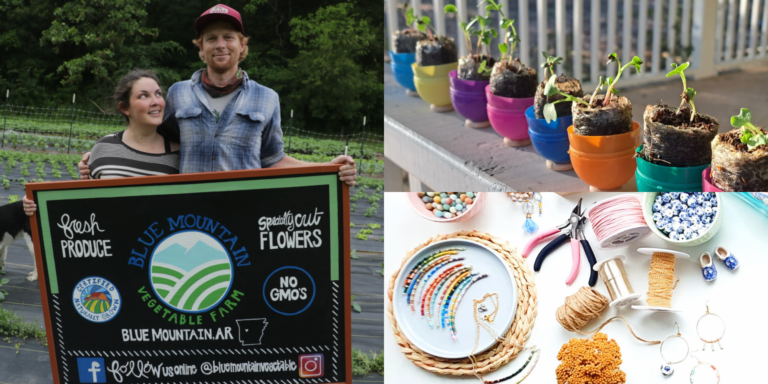How Racism Shows Up in the Food System — And What We Can Do About It
Systemic racism has a long, challenging history of influencing how and what we eat. Here’s what we can do about it.
Systemic racism has a long, challenging history of influencing how and what we eat. Here’s what we can do about it.

In Albuquerque, New Mexico, Mateo Carrasco thinks about healthy food as a tool for healing.
Through Project Feed the Hood, Carrasco, a food justice organizer at the SouthWest Organizing Project (SWOP), and his colleagues are “planting seeds for community needs,” using food education and traditional farming practices to encourage resilience and food sovereignty in young people. The children and teenagers Carrasco works with come primarily from low-income communities of color, who face systematic obstacles to accessing healthy, fresh foods.
“We’re talking about some of the most underserved schools in the entire country,” says Carrasco, also a former FoodCorps service member. “How can food justice be used as a tool for academic success?”
SWOP is one of many organizations seeking to counter the institutional racism that permeates our food systems — and has for generations. Unequal access to healthy food in our country is not accidental; our food systems were designed to restrict access to communities of color and privilege those with power, status, and resources. Historically, food access has been used as a tool to oppress BIPOC (Black, Indigenous, and People of Color) communities and deny the sovereignty, liberation, and community that comes with knowing where one’s food comes from.
Food justice activist Karen Washington refers to this phenomenon as food apartheid: the phenomenon of communities with little or no fresh, affordable food available, where residents must turn to fast food, convenience stores, or other food sources rather than shopping at a well-stocked grocery store.
But through dedicated food education and community building, organizers like Carrasco are righting this wrong, paving the way for a new system.
“My work is oriented toward making sure the youth in our society who are most vulnerable and that experience racism in their food system are the people who are ultimately going to be the ones to grow up to change it,” Carrasco says.
To understand America’s long tradition of denying BIPOC communities equal access to healthy food, we need look no further than our country’s origins.
There’s a pervasive myth about our country suggesting that when colonizers first came upon the United States, the land was hardly used. White colonizers believed the Indigenous peoples of the land needed their help to make the most of their resources. (This is referred to as settler colonialism.) In actuality, Indigenous people had been farming and tending the land since at least 8500 B.C., thriving and supporting their communities without the interference of Europeans.
As the United States developed, colonizers removed Indigenous people from their own land to make room for enslaved people from Africa, building their own wealth at the expense of Black people. Indigenous children were forcibly “assimilated” into the dominant culture at school, including through the foods they were served. The denial of their foodways, languages, and even their surnames was framed as “educating” them or even “civilizing” them, when it was in fact traumatizing them through the systemic removal of their identities.
“Even though it’s complex, racism is also fairly straightforward in that it happens on an interpersonal level,” says Jillian Dy, who works on supply chains at FoodCorps. “We as humans have a tendency to blame the system, and that lets us all off the hook when we all have to be taking personal responsibility.”
To this day, migrant workers make up a majority of farmworkers, where they are chronically underpaid, forced to work in unsafe conditions, and often unable to put food on their own tables. Industries like meatpacking plants are primarily staffed by BIPOC workers, whose role in the professional hierarchy leaves them unable to advocate for fair wages or safer working conditions. Even BIPOC farmers face economic obstacles and racist discrimination while trying to navigate increasingly complex supply chains, particularly those breaking into large-scale farming.
“Look around you at who can afford to eat, and who can afford to farm, and what incentives are in place that create the ability or inability for individuals to achieve those two things: eating good food and producing good food,” says Dy. “You can see a very clear division.”
Access to healthy food is also often limited by race, as low-income Black and Brown neighborhoods are more likely to be located far away from affordable, healthy food options. The term “food apartheid” is more accurate than terminology like “food desert” because the neighborhoods in question are not “deserted,” but rich with community life.
Furthermore, food-scarce areas are not naturally occurring like deserts, but intentionally designed by those with more power and resources. Food assistance programs like SNAP do too little to repair these inequities; under the Trump administration, for example, struggling Americans are having a harder time getting the food assistance they need.
This accumulation of factors results in poorer health outcomes for children of color, who are more likely than white children to face diet-related diseases. And according to Morgan McGhee, a registered dietitian who works on school nutrition leadership for FoodCorps, a lack of diversity in the field of dietetics itself skews the narrative about how these health outcomes happen.
“We lack the understanding of what white supremacy is and how it shows up,” McGhee says. “If that’s who’s delivering the narrative, there’s privilege and personal bias that comes into account. That is reflected in the programs you offer and the food you serve.”
Even in food justice spaces, racism shows up in how food educators approach food education with underserved communities. White saviorism, or the problematic concept of a white person “saving” or “rescuing” people of color in a way that’s ultimately self-serving, shows up too often when privileged white educators try to teach BIPOC children about what to eat. (FoodCorps is working — and struggling — to address our own troubling history of white saviorism in our work.)
“You can’t give a kid a bunch of kale and say, ‘Here, you’re saved.’ That’s how the savior mentality arises within food justice work itself,” Carrasco says. “Why am I going to sit here and tell a student they shouldn’t be eating hot Cheetos if that’s the only food they can afford?”
In the late 1960s, the activist group known as the Black Panther Party began a small volunteer effort to provide free, healthy breakfasts to local school children in Oakland, California.
What began with a few volunteers serving a handful of children at an Episcopal church turned into a massive operation. Soon, the Black Panthers were feeding thousands of children per day at more than 45 locations. Teachers reported obvious changes in the kids who had previously shown up to school with empty bellies; they were more awake, alert, and focused on their learning.
The Black Panthers were persecuted viciously by the government for their activism and their loud, unapologetic pushback to white supremacy, yet their work feeding kids formed the foundation of today’s school breakfast programs. And their guiding vision — “free breakfasts, free medical care, then free bus rides, and then you have freedom,” activist Fred Hampton once said — made a compelling case for healthy food access as a pathway to liberation.
Food is indeed one of the most powerful avenues to freedom. Deciding where your food comes from and how it’s prepared is an act of sovereignty. Passing cultural foodways down through families and communities is an important tradition. Denying BIPOC communities these opportunities is another way white supremacy rears its head, and it will take intentional work to undo it.
But what does liberation look like today? And what role can schools play in achieving it?
FoodCorps’ Morgan McGhee says that for an example of how this work is being done well, we should look toward innovative school nutrition professionals, who create space for families and communities to make their own decisions around food and nutrition.
“That’s exactly what they’re doing: they’re providing access, education, resources, and connection, so families can increase their self-efficacy so their own needs and wants are provided for,” McGhee says. “The school then becomes the change agent that allows them to do that.”
For food justice organizers, Mateo Carrasco says, it’s about cultivating a love and respect for food and land in the next generation, providing them with the tools to create meaningful relationships with the place where their food comes from.
“When I see a just food system, I see a place where hunger isn’t criminalized,” says Carrasco. “I see a society where we respect the environment and respect each other in relation to the environment. I see us shaping the world around us in a way that’s regenerative and restorative. That’s why we work so much with kids; once you see yourself as a steward of the land as opposed to someone who simply exists in a place, you begin to want to take care of it.”
FoodCorps’ Jillian Dy adds that growing, preparing, and selling food is an incredibly challenging industry. She says that an action as simple as cooking more frequently, growing your own produce, or joining a CSA, or community-supported agriculture, can help to garner a greater respect for what it takes to get food from the farm to your table.
In fact, CSAs have their roots in racial justice. The concept was developed in the 1960s by Booker T. Whatley, a Black horticulturist from Alabama who developed a “clientele membership club” allowing individuals to pay a fee to choose their own produce throughout the season.
“[When you join a CSA,] you are taking your food dollars and giving them to a farmer. It’s direct and it’s about transferring wealth in a way that is just different than going to shop at your regular big-box store,” Dy says.
But most important, McGhee says, is for white people and others with privilege to check their personal biases, unpack the beliefs they hold about food, nutrition, and culture, and refrain from making assumptions about what’s best for someone else.
“If you don’t account for personal bias; if you don’t say, ‘I’m not saving them, I’m an access point that’s going to help them become more food sovereign or help uplift their voices,’ you can go down a slippery slope of white supremacy,” McGhee says. “We want to make sure we’re centering the community if we are truly servants of a greater cause creating a more just world.”

5 Blender-Friendly Recipes For Sauces and More

Our 2024 Child Nutrition Policy Year in Review

9 Thoughtful Holiday Gifts Made by FoodCorps Alumni